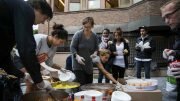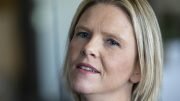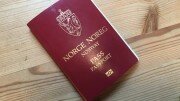During 2015, 37 100 people attended Norwegian language training and social studies for newly arrived immigrants – a 2 percent increase from 2014. A total of 4 500 of the participants were from Syria. This is nearly double the number from the previous year.
The number of participants in Norwegian language training and social studies for newly arrived immigrants increased from 36 200 to 37 100 from 2014 to 2015. This was a 2 percent increase. The number of participants in Norwegian language training for asylum seekers rose by 45 per cent, from 3 900 to 5 600 participants. These statistics include both of these schemes, and the figures are published separately. People who are granted a residence permit may be participants in both schemes during the same year. In 2015 and 2014, this applied to 1 800 and 1 000 persons respectively, and these are included in the figures for both schemes.
The biggest increase was from Syria
The number of participants in Norwegian language training and social studies from Syria nearly doubled from 2014 to 2015, from 2 300 to 4 500. The number from Eritrea increased by 20 per cent, from 6 100 to 7 300. The number of participants from Somalia and Thailand decreased by 12 per cent from 2014 to 2015.
In 2014, Syria had the fourth most participants. In 2015, Syria passed Thailand and was thus the country with the third most participants, after Somalia and Eritrea.
Also in the Introduction programme for immigrants, where Norwegian language training and social studies form a key part, there was a marked increase in participants from Syria and Eritrea from 2014 to 2015.
Still the most participants from Eritrea
In 2015, most participants in Norwegian language training and social studies came from Eritrea (7 300), Somalia (5 000) and Syria (4 500). Participants from these three countries accounted for 45 per cent of everyone who participated in the training in 2015. They were followed by Thailand (2 100), Philippines (1 800) and Afghanistan (1 700).
More men, but women still in the majority
The number of male participants in Norwegian language training and social studies increased by 10 per cent from 2014 to 2015. The increase was particularly high among men aged between 16 and 25 years.
There has been a decline of 3 per cent in the number of female participants. Nevertheless, there were still more female than male participants in the training in 2015, with 53 per cent and 47 per cent respectively.
Most male participants from Syria and Eritrea
There were more male than female participants from Syria and Eritrea, with 73 and 68 per cent male participants respectively. From Somalia, 47 per cent of the participants were men. Among the participants from Thailand and the Philippines on the other hand there was a large majority of women. Here the male participants represented 5 and 12 per cent respectively.
Most men among the most newly arrived participants
The right to 600 hours of participation in Norwegian language training and social studies is initially granted for three years after the first residence permit. Additional training may be given within 5 years from the first residence permit. 86 per cent of the participants in 2015 had three or fewer years of residence. There are more men than women among participants with less than two years of residence, while the women are in the majority among those with two or more years of residence.
Most participants in the largest cities
Most participants in Norwegian language training and social studies in 2015 were living in Oslo. A total of 5 220 participants were living here at the end of the year. Then followed Bergen (2 040), Trondheim (1 470), Stavanger (930), Kristiansand (840), Bærum (720), Drammen (620) and Sandnes (540). The municipality of residence is responsible at any given time for providing training in Norwegian language training and social studies.
More participants in language training for asylum seekers
Asylum seekers over 16 years living in ordinary asylum reception centres, and who have not received a residence permit, can get up to 175 hours of Norwegian language training for asylum seekers. In 2015, 5 600 people participated in this training. This is an increase from 3 900 in 2014. Of those who participated in language training for asylum seekers in 2015, 1 800 were later granted a valid residence permit in that year and also participated in Norwegian language training and social studies for adult immigrants in 2015. In 2014, there were 1 000 people who participated in both schemes during the year.
Source: SSB / Norway Today





